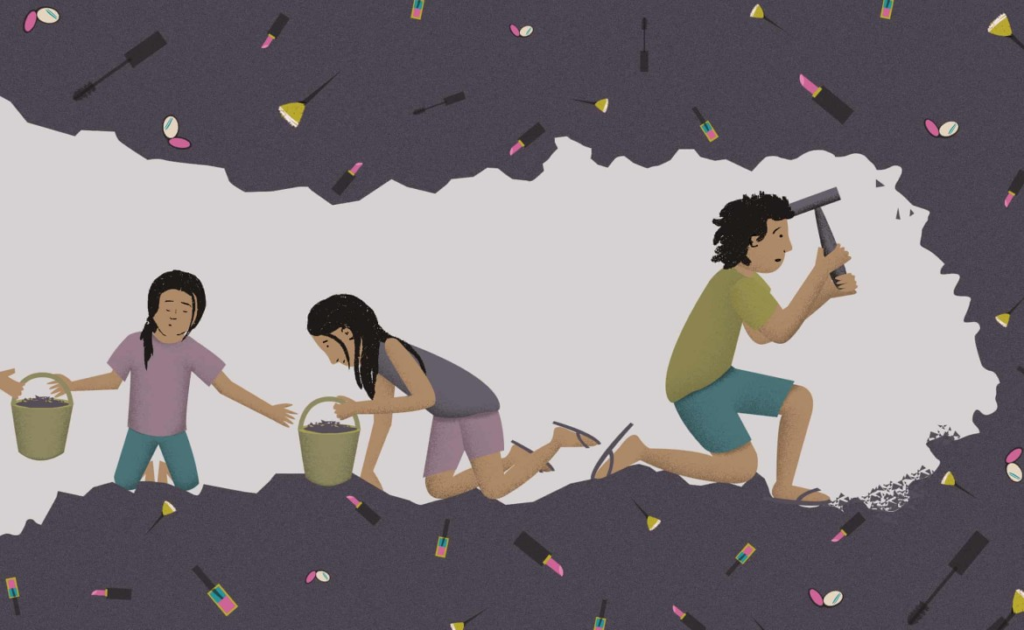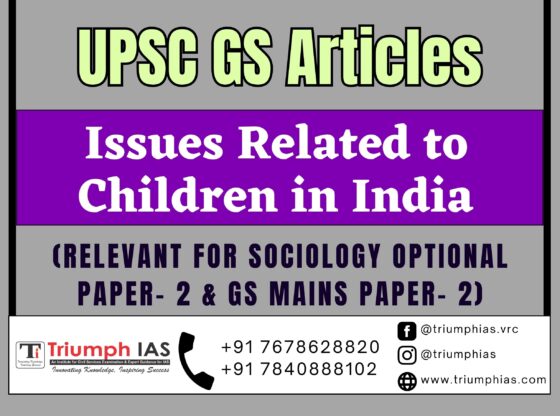Issues Related to Children in India
Relevant for sociology optional Paper- 2 & GS Mains Paper- 2

India, the seventh-largest country in the world, is home to more than 1.3 billion people. Out of this massive population, approximately 41% are children below the age of 18. However, despite India’s numerous economic and social advancements, children in the country still face a wide range of issues. These issues arise due to various factors such as poverty, lack of education, discrimination, child labour, and child trafficking, among others.
One of the most significant challenges that children in India face is poverty. Poverty can have a detrimental effect on children’s overall development, including their health, education, and well-being. According to a report by UNICEF, approximately 30% of children in India live in poverty, and they lack access to basic necessities such as food, shelter, and clothing. This lack of access to basic necessities can result in malnutrition and other health-related problems, which can negatively impact their overall physical and mental development.
Education is another area where children in India face a multitude of challenges. Although India has made significant strides in education in recent years, a considerable number of children still do not have access to quality education. According to a report by the National Sample Survey Organization, nearly 35 million children between the ages of 6 and 14 years do not attend school. Furthermore, there is a significant gender gap in education, with girls often being excluded from formal education due to societal norms and cultural beliefs.
Child labor is another significant issue that affects children in India. According to a report by the International Labour Organization (ILO), India has the largest number of child labourers in the world, with an estimated 10.1 million children between the ages of 5 and 14 years working in various sectors. Many of these children are forced to work in hazardous conditions, and they do not receive proper remuneration for their labour. This lack of education and exposure to harmful working conditions can hinder their future prospects and overall development.
Discrimination against children is also a widespread issue in India. Discrimination can take many forms, such as caste, gender, religion, and socio-economic status. Children from marginalized communities are particularly vulnerable to discrimination, which can lead to a lack of access to basic necessities such as healthcare and education. Discrimination can also lead to child marriage, which is prevalent in many parts of India. Child marriage can result in a host of health-related problems, including early pregnancy, which can have severe consequences for both the mother and child.
Child trafficking is another significant issue that affects children in India. Children are trafficked for various reasons, including sexual exploitation, forced labour, and domestic servitude. According to a report by the National Crime Records Bureau, there were over 15,000 cases of child trafficking in India in 2016, with a majority of the victims being girls. Child trafficking can have long-lasting effects on the physical and mental well-being of children, and it can hinder their overall development.
Child abuse is also a widespread issue in India. Child abuse can take many forms, such as physical, sexual, and emotional abuse. According to a report by the Ministry of Women and Child Development, over 10,000 cases of child abuse were reported in India in 2016, with a majority of the victims being girls. Child abuse can result in long-term psychological trauma and can negatively impact a child’s overall development.
In conclusion, children in India face a wide range of issues that can hinder their overall development and well-being. Poverty, lack of education, discrimination, child labour, child trafficking, and child abuse are some of the significant challenges that need to be addressed. To address these challenges, it is essential to prioritize the needs of children and ensure that they have access to basic necessities such as healthcare, education, and protection from these issues. The government, civil society, and individuals must work together to create a conducive environment that promotes and protects children’s rights. This can be achieved through the implementation of policies and programs that prioritize children’s well-being, such as education and healthcare initiatives, child protection laws, and awareness campaigns. Additionally, there is a need for increased collaboration and partnership between various stakeholders to address these challenges effectively. By prioritizing the needs of children, India can ensure that its future generations have access to the resources and opportunities they need to thrive and contribute positively to society.
For more such free UPSC notes, Articles, News & Views Join our Telegram Channel. https://t.me/triumphias
Click the link below to see the details about the UPSC – Civils courses offered by Triumph IAS. https://triumphias.com/pages-all-courses.php


